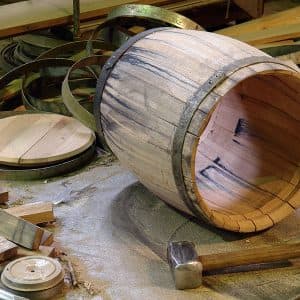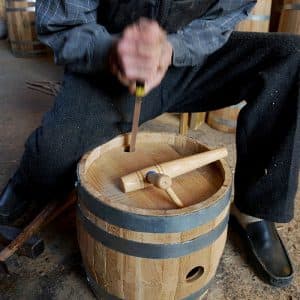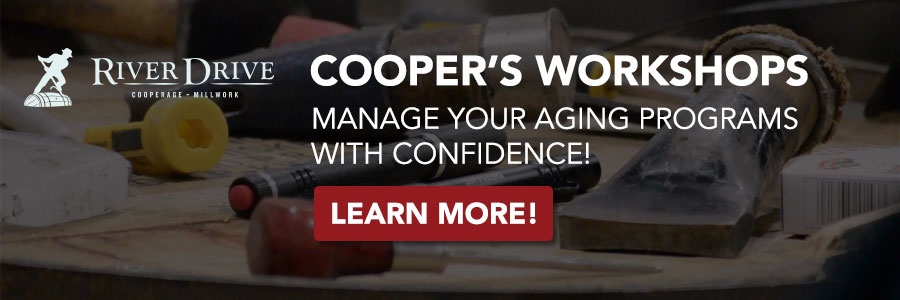While the coopers’ art is one that spans a myriad of functions, perhaps none are more interesting than barrel making. It is a precise art and although technology has advanced, the barrel making process has survived for centuries with very few changes.
The process begins with selection of wood. While barrels can be made of many different materials, oak wood is the most common. Both French and American oak are used in barrel making. So, what’s the difference between French and American oak? To put it simply, French oak adds more subtle flavor to wine, while American oak is more assertively flavored.

Oak barrel being assembled
Originally, wood for American oak barrels was kiln dried. While suitable for spirits, the kiln drying was leaving a much too aggressive flavor in the wood. When American coopers began air drying American oak like the French coopers, the resulting barrels, while still more powerful than the French, were much better suited for wine production. American oak barrels have made remarkable progress in terms of quality over the past few decades. Many of the differences between many American barrels and French barrels are now more a matter of style than of quality.
Wood is harvested from trees hand-selected by the cooper, or barrel maker, to ensure a uniform and water tight final product. The wood is split or sawn from the trees and formed into long thin strips, called staves. The staves need to then dry for a while before they are ready to be formed. They are stacked, and left to sit in the elements for up to several years.
Once they are fully dry, the staves are shaped so that each is wider in the middle and slightly tapered at the ends. This shape is important, as a cooper’s work must be water tight without the use of screws or glue. The staves are hand selected by the cooper to ensure the tightest fit and assembled inside of a metal hoop that serves as an assembly jig. With this, the barrel begins to take its familiar shape.
The assembled staves are then subjected to both heat and humidity to make the wood flexible. A wood fire and water spray make this possible. As the wood flexes and bends, hoops of varying size are used to hold the staves tightly in place. Historically, hoops were made of flexible pieces of wood called “withies,” but nowadays are made from galvanized iron.

Cooper adding a spigot to a wooden barrel
As the barrel sits over the fire, the inside naturally becomes charred. This results in a “toast level” on which the flavor of the barrel contents will partially depend. The heat caramelizes sugars in the wood, giving rise to new compounds that add complexity. Toast levels can generally be adjusted per the customers request and different levels will impart more or less intensity of flavor.
While the barrel is now mostly complete, a precise machining step is necessary to trim the ends of the staves and to cut the “croze,” the groove in the stave that receives the barrel heads. Custom cut to fit the croze, the heads are produced with more wood held together with wooden dowels. The barrel is then set upright and heads are fit, finished off with a final hooping that will keep everything in place.
Once a barrel is complete it is tested to make certain it is water tight. If it passes inspection, the cooper sands and planes the barrel. The cooper then signs or stamps his work and the barrel is complete!
Have more questions about how barrels are made, repaired, and used? Here at Barrels Direct, our business is all things barrel – we’re here to answer questions and guide you in the right direction for your particular barrel needs. Contact us to let us know how we can help!



David G
Is only heart wood used in barrels? Or is sap wood allowed?
Matt Albrecht
Mostly heartwood. Luckily White Oak has just a very thin layer of sapwood!
Ivo
Is there a special method to split the logs so the pores dont let the product leak out?
Matt Albrecht
Yes! Logs are split lengthwise into 4 pieces, like a pie. The pieces are then sawn in a style commonly called “Rift Sawn” or “Quarter Sawn”.